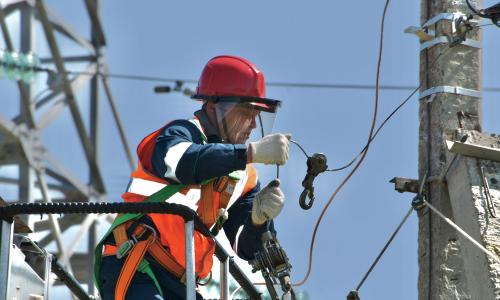Innovative programs around the country now make it possible for all environmentally conscious energy consumers to support renewable energy directly by participating in the "green" power market. The willingness to pay for the benefits of increasing our renewable energy supplies can be tapped within any market structure and by any size or type of energy consumer.
What is green power?
Green power is the solution to a cleaner, sustainable energy system. Renewable energy—power from the sun, wind, plants, and moving water—is a sustainable way to meet our energy needs and protect the environment and public health.
- Wind energy converts the power available in moving air into electricity. Wind power does not produce emissions, generate solid waste, or use water.
- Bioenergy is energy from trees and plants. This includes crops grown specifically for energy production and organic wastes (such as wood residues from paper mills and methane from landfills). Using bioenergy to generate electricity reduces global warming emissions if new plants are grown to replace those that are harvested.
- Geothermal energy uses heat from inside the earth to make clean power.
- Solar power captures the heat and light of the sun to generate electricity. Solar energy does not produce emissions, generate solid waste, or use water.
- Hydroelectric power captures the energy in falling water. It does not produce emissions or solid waste, but can have a relatively low or high impact on the environment, depending on the site-specific factors such as maintenance of water flow and water quality, fish impacts, and other land use issues.
Why buy green power?
Choosing green power could make a big difference for the environment because electricity generation is the largest industrial polluter in the country. Electricity generation currently produces:
- About two-thirds of the annual U.S. emissions of sulfur dioxide, the main cause of acid rain and very small soot particles. These fine particles are believed to be responsible for the largest share of the 50,000-100,000 deaths caused by air pollution in the United States each year.
- About 30 percent of the nitrogen oxide emissions, which stress forest ecosystems and combine with organic compounds in sunlight to form smog. High smog levels can also trigger heart and respiratory problems and contribute to air pollution deaths.
- About 40 percent of the carbon dioxide emissions. This heat-trapping gas causes global warming, which may lead to increased droughts, flooding, disease, ecosystem disruption, and severe weather.
- Toxic-metal emissions (such as mercury and lead) and nuclear waste.
What are the dirtiest energy sources?
All fossil fuels and nuclear power contribute to one or more of the problems mentioned above. Since these power sources currently account for more than 90 percent of the electricity generated in the United States, it is not possible to avoid them altogether. But some are worse than others, and you can try to minimize their use.
Coal. Most electricity in the United States currently comes from coal. But coal burning is the leading cause of acid rain, the largest source of global warming emissions, and a significant source of smog, toxic metals, and tiny-particle pollution. Reducing coal usage is critical to slowing global warming and protecting the environment.
Oil. Oil produces high levels of sulfur dioxide and nitrogen oxides and relatively high levels of carbon dioxide, as well as problems associated with drilling, refining, and transportation, such as tanker spills. Furthermore, the increasing U.S. dependence on imported oil is economically risky and will continue to increase the U.S. trade deficit.
Nuclear power. After coal, the next largest source of our electricity is nuclear power. While nuclear plants don't cause air pollution, they do create radioactive waste, which must be stored for thousands of years. As accidents at Three Mile Island and Chernobyl proved, nuclear plants also carry the risk of catastrophic failure. And nuclear power can be very expensive.
What about natural gas?
In 2004, natural gas accounted for about 19 percent of the U.S. electricity mix. Use of natural gas is projected to increase dramatically in the next two decades if we continue on our current path, but supplies are limited and imports are increasing. Our growing reliance on natural gas combined with limited supplies makes this fuel subject to price spikes, which can have a significant impact on consumer energy costs. In addition, though natural gas is much cleaner than coal or oil, it does produce global warming emissions when burned. So, while the use of natural gas serves as a good transition to a cleaner future, it is not the ultimate solution.
What are my green power options?
Green Pricing
Green Pricing is an optional utility service for customers who want to help expand the production and distribution of renewable energy technologies. With green pricing, you do not have to change your electricity provider. Instead, customers choose to pay a premium on their electricity bill to cover the extra cost of purchasing clean, sustainable energy. As of March 2006, more than 600 utilities, electricity providers in 36 states offer a green pricing option.
The majority of green pricing programs charge a higher price per kilowatt-hour to support an increased percentage of renewable sources or to buy discrete kilowatt-hour blocks of renewable energy. Other programs have fixed monthly fees, round up customer bills, charge for units of renewable capacity, or offer renewable energy systems for lease or purchase.
Green Marketing
Green marketing is the sale of green power in competitive markets, where consumers have the option to choose from a variety of suppliers and service offerings, much like they can choose between long-distance telephone carriers. The key difference between green marketing and green pricing is that with green marketing, you are actually switching electricity providers.
Green marketing is offered in Connecticut, Maine, Maryland, Massachusetts, New Jersey, New York, Pennsylvania, Rhode Island, Texas, Virginia, and the District of Columbia.
Renewable Energy Certificates
Consumers throughout the United States have a third green power option: Renewable Energy Certificates (RECs or sometimes "green tags"). A REC represents the environmental attributes or benefits of renewable electricity generation (usually one credit = one kilowatt-hour). RECs can be purchased in almost any quantity and are usually available from someone other than your electricity provider. What you pay for is the benefit of adding clean, renewable energy generation to the regional or national electricity grid. The overall environmental benefit of purchasing a green pricing or green marketing product versus RECs is exactly the same. RECs provide a "green" option for people in any state, but are ideal for people who live in states where green pricing and green marketing options are not available.
How can you tell if you're buying green power?
When power flows from the generator to your house, electrons get mixed together on the wires. You can't specify which electrons you get, but you can make sure that your money goes to support clean, sustainable generators, which has the effect of making the whole system "greener". To do this, you will need to look closely at utility marketing claims and materials. To ensure that the claims are truthful, many states now require disclosure labels, just like the nutrition labels on food packages. But don't hesitate to ask for more information directly from potential suppliers, including the percentage of power derived from each fuel source and the level of each of the above emissions compared with the regional average.
Other important information to discover is whether a company's renewable offering will lead to new projects, so that you know your money is adding to renewable energy use in your region, and whether the company provides comprehensive energy-efficiency services to help reduce your power use and your bill. Be skeptical and ask questions.
Green-e is a voluntary certification program for renewable electricity products. The Green-e program establishes consumer protection and environmental standards for electricity products, and verifies that these products meet the standards. The Green-e logo certifies that at least half the power supplied is from renewable sources. Many products will carry the Green-e logo, and the best way to find the most environmentally sensitive providers is by doing some comparison research. To find out which Green-e certified products are available in your state, visit Green-e's electric choices page. Questions about particular providers can be directed to the Center for Resources Solutions, which administers the Green-e program, at (415) 561-2100.
Power Scorecard is a web tool that rates the environmental quality of electricity offered to customers in California, New Jersey, New York, Pennsylvania, and Texas. It will help identify products that have the lowest overall environmental impact on our air, land, and water, and those that will lead to the development of the most new renewable energy generation. Power Scorecard will be expanding into other states in the near future.
The future
Some renewable power sources now cost somewhat more than conventional power, because the market for renewable energy is not fully developed and renewables have received fewer subsidies than fossil and nuclear fuels. Also, the damage to the environment and human health—otherwise known as externalities—caused by fossil fuels and nuclear power is not included in electricity prices. Renewable energy needs your support to overcome these barriers and become less expensive in the future. Look into becoming a green power consumer today!



